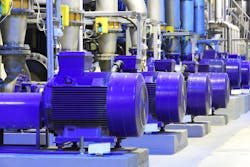In the 19th century, steelmaking was an extremely expensive process and its production was restricted to very small quantities, used mainly for cutlery, important tools, and swords. However, Henry Bessemer in 1860 made the production of steel easier and cheaper. Over 150 years later, there are still aspects of manufacturing that are unnecessarily expensive. Here, Jonathan Wilkins, marketing director at automation parts supplier EU Automation, explores the best ways of reducing costs related to running a motor.
An electric motor is a device that converts electrical energy into rotary kinetic energy, powering many diverse processes like a drive, fan, pump or conveyor belt. Each process requires a specific motor, with specialized characteristics for each unique function.
Cruise Control
However, motors traditionally run on a single-speed system, they’re either running top speed or not running at all. Running at high speeds can waste a lot of energy, especially if the application doesn’t require the top speed to function. To manage this energy wastage, variable speed drives (VSDs) can be fitted to a single-speed motor to improve its efficiency. VSDs convert the fixed incoming power to a variable voltage and then manage the motor’s output speed according to the device’s changeable demands. The addition of a VSD has the potential to reduce the energy consumption of a facility by at least 10%.
Slow it Down
Starting up a motor can cause a lot of wear and ultimately reduce the lifespan of the device. Fixed speed motors accelerate extremely quickly to reach their correct, operational speed, requiring high current and creating a great deal of heat as a result. To prevent too much wear, it is common to limit the number of times a motor starts up per hour. Introducing a soft starter can allow an increased start-up limit and reduce the stress during start-up by limiting the current to the motor, therefore avoiding increased mechanical wear and overheating of electrical parts.
Housekeeping
You don’t have to upgrade your equipment or install costly smart sensors to reduce the cost of your motors, a lot of cost-cutting solutions can come from introducing general energy-saving improvements to a facility. For example, motors are often left running when they’re not needed. Unnecessary use can add up to £2,000 a year per motor to the energy bill and increase wear.
The surrounding environment of the motor should also be monitored to achieve the highest efficiency. Keeping motors out of areas in the facility that have high temperatures can reduce overheating. It’s also important to keep the motor clean and away from machinery that might emit a lot of dust or debris to prevent breakages.
Using a predictive maintenance program to plan when maintenance is most needed and avoid unplanned downtime, will greatly reduce the costs if something were to go wrong. If a breakage does occur, instead of investing in a brand-new model, manufacturers can save by opting for a reconditioned part from a reliable supplier. Eco-obsolete technology, which still adheres to energy efficiency standards despite not being brand new, is a cost-effective option for manufacturers.
Like Henry Bessemer’s steelmaking discovery, introducing new technologies and machinery can result in long-term cost reductions. However, there are also more simple ways to achieve the same outcome. Whether you outfit your current equipment with VSDs or re-evaluate the position of your motors within the facility, there is potential to reduce the costs of owning and running a motor.
About the Author

